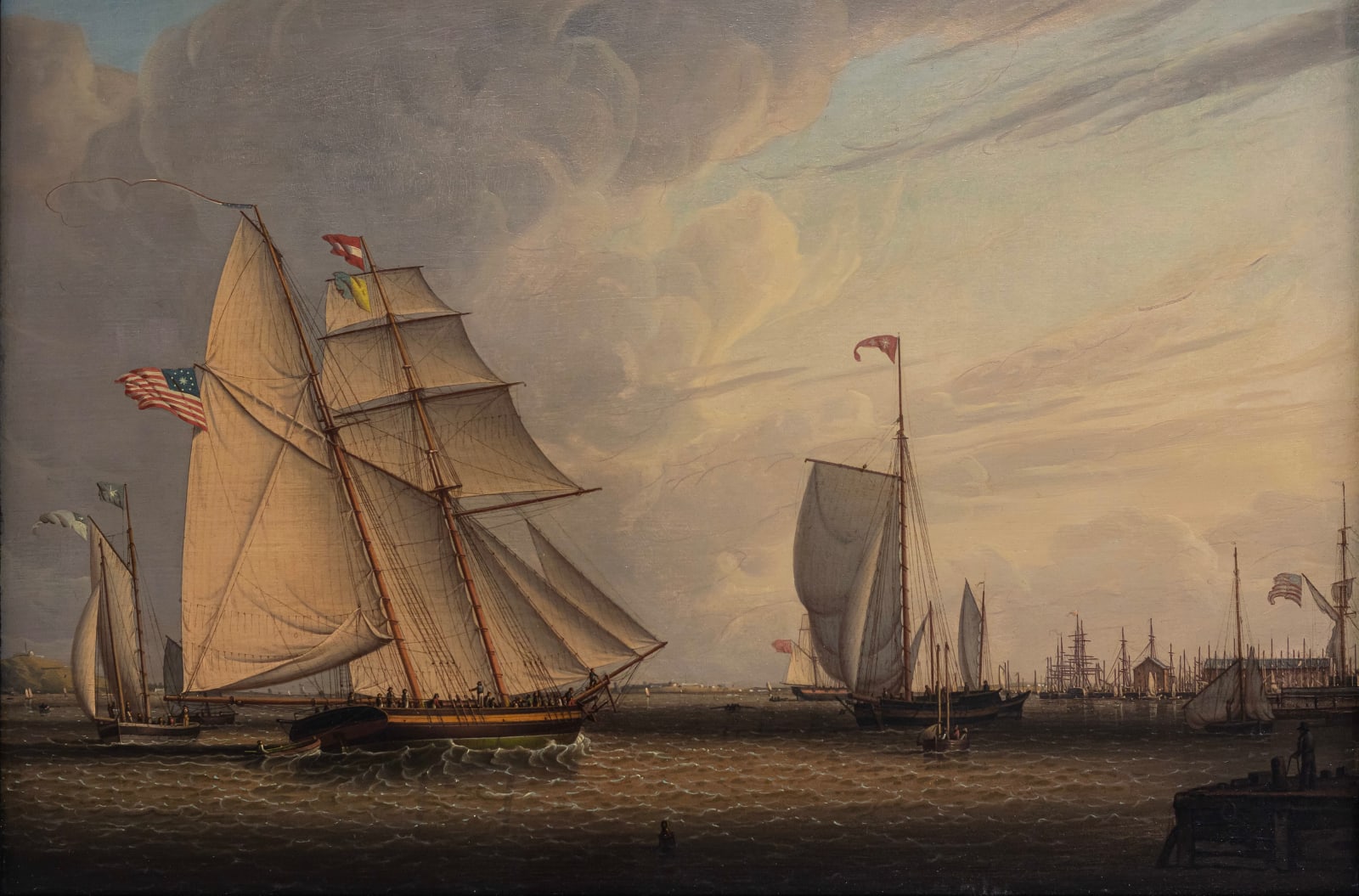Robert Salmon
41.6 x 61 cm
Robert Salmon painted Sailing Vessels in Boston Harbor in 1829, the year after his arrival in Massachusetts, where he became one of the leading American maritime painters of the day. The painting captures a lively waterfront scene and faithfully records Boston harbor looking in the direction of Fort Independence. Salmon’s masterful skill as a draftsman is evident in the intricate details of the schooner’s rigging and the cluster of masts on the horizon. In contrast, Salmon explored the expressive possibilities of the water in the animated pattern of the waves and the billowing clouds.
John Wilmerding referred to the present work completed shortly after Salmon's arrival in Boston: “During the rest of 1829 Salmon turned more fully to painting what he loved best, views of the harbor and portraits of ships. His total number of pictures that year was under two dozen, and individual works seldom brought more than thirty dollars, often as little as eight. Two notable exceptions were paintings purchased by the eminent Bostonian, Thomas Handasyd Perkins for thirty-five dollars apiece (Nos. 644 and 645).” [1] This striking example of Salmon's mature period appealed to Perkins, who became his major patron and philanthropist who contributed to the Boston Athenaeum, Perkins School for the Blind, and Museum of Fine Arts.
Salmon’s singular style is rooted in Old Master painting and finds echoes, for instance, in the calm waters and dramatic skies of French baroque painter Nicolas Poussin. Salmon advanced these visual devices, however, and ultimately developed a uniquely American approach, seen here in the specificity of Boston subject and handling of light on the water. Today, Salmon is widely considered to be a founder of Luminism, a movement nineteenth-century American art scholar Barbara Novak famously described as “one of the most truly indigenous styles in the history of American art,” as it originated apart from European painterly traditions and showcased the unique majesty of the North American landscape. [2] His legacy extends through the next generation of Hudson River School artists including Fitz Henry Lane.
[1] John Wilmerding, Robert Salmon: Painter of Ship & Shore, Salem, Massachusetts: Peabody Museum of Salem, 1971, p. 40.
[2] Barbara Novak, American Painting of the Nineteenth Century: Realism, Idealism, and the American Experience, New York: Harper & Row, Publishers, Inc., 1979, p. 95.
Provenance
The artist;Colonel Thomas Handasyd Perkins, Boston;
Augustus Thorndike Perkins, Boston (his grandson);
Elizabeth G. Perkins Wadsworth (his daughter);
William P. Wadsworth, Boston (her son);
Private collection, Pennsylvania;
[Hirschl & Adler Galleries, New York]; to
Walter B. and Marcia F. Goldfarb, Portland Maine, 1974; to
Estate of Walter B. Goldfarb, 2021
Exhibitions
Hirschl & Adler, New York, Quality: An Experience in Collecting, November 12-December 7, 1974, no. 42, illus.Whitney Museum of American Art, New York, Seascape and the American Imagination, June 10-September 7, 1975, no. 84
Portland Museum of Art, Maine, A Magnificent Stillness: American Art from a Private Collection, June 26-November 8, 2015, n.p., illus. pl. 2
Portland Museum of Art, Maine, 2021-2022 (on long-term loan)
Literature
Catalogue of Robert Salmon's Pictures 1828 to 1840, no. 645Carl Seaburg and Stanley Paterson, Merchant Prince of Boston: Colonel T. H. Perkins 1764-1854, Cambridge, Massachusetts: Harvard University Press, 1971, p. 398
John Wilmerding, Robert Salmon, Painter of Ship & Shore, Peabody Museum of Salem, 1971, pp. 40, 91, no. 645
Roger B. Stein, Seascape and the American Imagination, New York: Whitney Museum of American Art, 1975, pp. 57, 60, 66, no. 84, illus. pl. IV
Subscribe to our mailing list to receive updates from the gallery
* denotes required fields
We will process the personal data you have supplied in accordance with our privacy policy (available on request). You can unsubscribe or change your preferences at any time by clicking the link in our emails.

